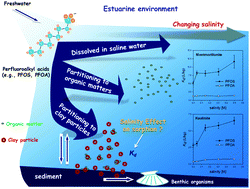Effects of salinity and organic matter on the partitioning of perfluoroalkyl acid (PFAs) to clay particles
Abstract
The influence of salinity and organic matter on the distribution coefficient (Kd) for

* Corresponding authors
a
Department of Environmental Science and Engineering, Gwangju Institute of Science and Technology (GIST), 1 Oryong-dong, Buk-gu, Gwangju, Korea
E-mail:
sdkim@gist.ac.kr
Fax: +82 62 715 2434
Tel: +82 62 715 2445
b
Department of Environmental Chemistry, EAWAG, Swiss Federal Institute of Aquatic Science and Technology, Ueberlandstrasse 133, Duebendorf, Switzerland
E-mail:
junho.jeon@eawag.ch
Fax: +41 44 823 5028
Tel: +41 44 823 5042
c Wadsworth Center, New York State Department of Health, Department of Environmental Health Sciences, School of Public Health, State University of New York at Albany, Empire State Plaza, P. O. Box 509, Albany, New York, USA
d Yeongsan River Environmental Research Laboratory, 1110-8 Oryong-dong, Buk-gu, Gwangju, Korea
e Department of Bioscience and Biotechnology, Chungnam National University, 220 Gung-dong, Yuseong-gu, Daejeon, Korea
The influence of salinity and organic matter on the distribution coefficient (Kd) for

 Please wait while we load your content...
Something went wrong. Try again?
Please wait while we load your content...
Something went wrong. Try again?
J. Jeon, K. Kannan, B. J. Lim, K. G. An and S. D. Kim, J. Environ. Monit., 2011, 13, 1803 DOI: 10.1039/C0EM00791A
To request permission to reproduce material from this article, please go to the Copyright Clearance Center request page.
If you are an author contributing to an RSC publication, you do not need to request permission provided correct acknowledgement is given.
If you are the author of this article, you do not need to request permission to reproduce figures and diagrams provided correct acknowledgement is given. If you want to reproduce the whole article in a third-party publication (excluding your thesis/dissertation for which permission is not required) please go to the Copyright Clearance Center request page.
Read more about how to correctly acknowledge RSC content.
 Fetching data from CrossRef.
Fetching data from CrossRef.
This may take some time to load.
Loading related content
